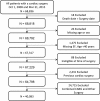Prevalence and Long-Term Survival After Coronary Artery Bypass Grafting in Women and Men With Heart Failure and Preserved Versus Reduced Ejection Fraction
- PMID: 29909401
- PMCID: PMC6220539
- DOI: 10.1161/JAHA.118.008902
Prevalence and Long-Term Survival After Coronary Artery Bypass Grafting in Women and Men With Heart Failure and Preserved Versus Reduced Ejection Fraction
Abstract
Background: Heart failure (HF) with reduced ejection fraction (rEF) is a widely regarded prognosticator after coronary artery bypass grafting. HF with preserved ejection fraction (pEF) accounts for up to half of all HF cases and is associated with considerable morbidity and mortality in hospitalized cohorts. However, HFpEF outcomes have not been elucidated in cardiac surgical patients. We investigated the prevalence and outcomes of HFpEF and HFrEF in women and men following coronary artery bypass grafting.
Methods and results: We conducted a retrospective cohort study in Ontario, Canada, between October 1, 2008, and March 31, 2015, using Cardiac Care Network and Canadian Institute of Health Information data. HF is captured through a validated population-based database of all Ontarians with physician-diagnosed HF. We defined pEF as ejection fraction ≥50% and rEF as ejection fraction <50%. The primary outcome was all-cause mortality. Analyses were stratified by sex. Mortality rates were calculated using Kaplan-Meier method. The relative hazard of death was assessed using multivariable Cox proportional hazard models. Of 40 083 patients (20.6% women), 55.5% had pEF without HF, 25.7% had rEF without HF, 6.9% had HFpEF, and 12.0% had HFrEF. Age-standardized HFpEF mortality rates at 4±2 years of follow-up were similar in women and men. HFrEF standardized HFpEF mortality rates were higher in women than men.
Conclusions: We found a higher prevalence and poorer prognosis of HFpEF in women. A history of HF was a more important prognosticator than ejection fraction. Preoperative screening and extended postoperative follow-up should be focused on women and men with HF rather than on rEF alone.
Keywords: coronary artery bypass graft surgery; ejection fraction; heart failure; heart failure with preserved ejection fraction; heart failure with reduced ejection fraction; mortality; prognosis; sex.
© 2018 The Authors. Published on behalf of the American Heart Association, Inc., by Wiley.
Figures





Similar articles
-
Survival After Coronary Artery Bypass Grafting in Patients With Preoperative Heart Failure and Preserved vs Reduced Ejection Fraction.JAMA Cardiol. 2016 Aug 1;1(5):530-8. doi: 10.1001/jamacardio.2016.1465. JAMA Cardiol. 2016. PMID: 27434816
-
Comparison of 5-Year Outcomes After Coronary Artery Bypass Grafting in Heart Failure Patients With Versus Without Preserved Left Ventricular Ejection Fraction (from the CREDO-Kyoto CABG Registry Cohort-2).Am J Cardiol. 2015 Aug 15;116(4):580-6. doi: 10.1016/j.amjcard.2015.05.020. Epub 2015 May 21. Am J Cardiol. 2015. PMID: 26092271
-
Sex and Race Differences in Lifetime Risk of Heart Failure With Preserved Ejection Fraction and Heart Failure With Reduced Ejection Fraction.Circulation. 2018 Apr 24;137(17):1814-1823. doi: 10.1161/CIRCULATIONAHA.117.031622. Epub 2018 Jan 19. Circulation. 2018. PMID: 29352072 Free PMC article.
-
Outcomes of heart failure with preserved ejection fraction in a Southeast Asian cohort.J Cardiovasc Med (Hagerstown). 2015 Sep;16(9):583-90. doi: 10.2459/JCM.0000000000000100. J Cardiovasc Med (Hagerstown). 2015. PMID: 25022929 Review.
-
Sudden death in heart failure with preserved ejection fraction and beyond: an elusive target.Heart Fail Rev. 2019 Nov;24(6):847-866. doi: 10.1007/s10741-019-09804-2. Heart Fail Rev. 2019. PMID: 31147814 Review.
Cited by
-
Multiple arterial coronary bypass grafting is associated with greater survival in women.Heart. 2021 Jun;107(11):888-894. doi: 10.1136/heartjnl-2020-317737. Epub 2020 Oct 20. Heart. 2021. PMID: 33082174 Free PMC article.
-
Disability-free survival after coronary artery bypass grafting in women and men with heart failure.Open Heart. 2018 Nov 5;5(2):e000911. doi: 10.1136/openhrt-2018-000911. eCollection 2018. Open Heart. 2018. PMID: 30487983 Free PMC article.
-
Long-term Outcomes in Patients With Severely Reduced Left Ventricular Ejection Fraction Undergoing Percutaneous Coronary Intervention vs Coronary Artery Bypass Grafting.JAMA Cardiol. 2020 Jun 1;5(6):631-641. doi: 10.1001/jamacardio.2020.0239. JAMA Cardiol. 2020. PMID: 32267465 Free PMC article.
-
Heart failure - does ejection fraction hold any relevance?Indian J Thorac Cardiovasc Surg. 2022 Jan;38(1):1-4. doi: 10.1007/s12055-021-01295-x. Epub 2021 Nov 13. Indian J Thorac Cardiovasc Surg. 2022. PMID: 34898871 Free PMC article. No abstract available.
-
Short-term and long-term outcomes of revascularization interventions for patients with severely reduced left ventricular ejection fraction: a meta-analysis.ESC Heart Fail. 2021 Feb;8(1):634-643. doi: 10.1002/ehf2.13141. Epub 2020 Dec 3. ESC Heart Fail. 2021. PMID: 33274612 Free PMC article.
References
-
- Wrobel K, Stevens SR, Jones RH, Selzman CH, Lamy A, Beaver TM, Djokovic LT, Wang N, Velazquez EJ, Sopko G, Kron IL, DiMaio JM, Michler RE, Lee KL, Yii M, Leng CY, Zembala M, Rouleau JL, Daly RC, Al‐Khalidi HR. Influence of baseline characteristics, operative conduct, and postoperative course on 30‐day outcomes of coronary artery bypass grafting among patients with left ventricular dysfunction: results from the surgical treatment for ischemic heart failure (STICH) trial. Circulation. 2015;132:720–730. - PMC - PubMed
-
- Hillis GS, Zehr KJ, Williams AW, Schaff HV, Orzulak TA, Daly RC, Mullany CJ, Rodeheffer RJ, Oh JK. Outcome of patients with low ejection fraction undergoing coronary artery bypass grafting: renal function and mortality after 3.8 years. Circulation. 2006;114:I414–I419. - PubMed
-
- Bhatia RS, Tu JV, Lee DS, Austin PC, Fang J, Haouzi A, Gong Y, Liu PP. Outcome of heart failure with preserved ejection fraction in a population‐based study. N Engl J Med. 2006;355:260–269. - PubMed
Publication types
MeSH terms
LinkOut - more resources
Full Text Sources
Other Literature Sources
Medical
Research Materials
Miscellaneous

